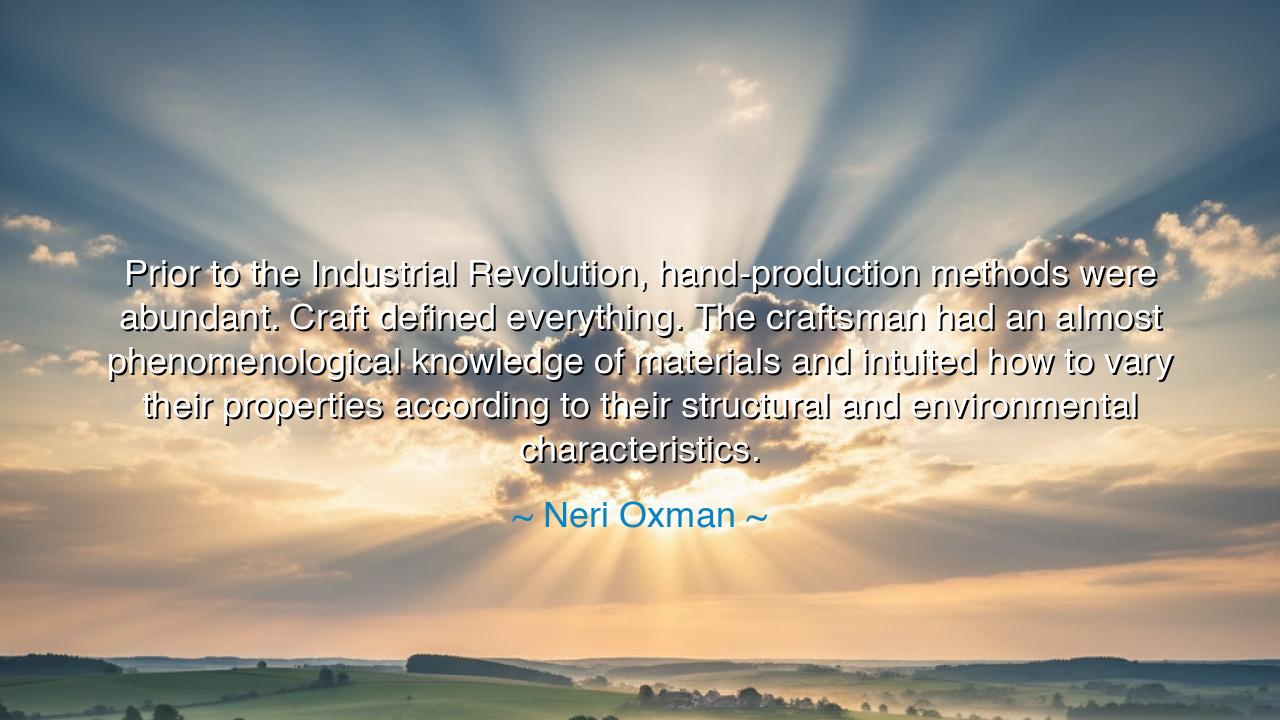
Prior to the Industrial Revolution, hand-production methods were
Prior to the Industrial Revolution, hand-production methods were abundant. Craft defined everything. The craftsman had an almost phenomenological knowledge of materials and intuited how to vary their properties according to their structural and environmental characteristics.






“Prior to the Industrial Revolution, hand-production methods were abundant. Craft defined everything. The craftsman had an almost phenomenological knowledge of materials and intuited how to vary their properties according to their structural and environmental characteristics.” Thus spoke Neri Oxman, the architect, designer, and visionary whose work stands at the intersection of nature, art, and technology. In these words, she summons the memory of a lost world — a world where creation was not mechanical, but intimate, where every object carried the fingerprint of its maker and every act of shaping matter was also an act of understanding. Her reflection is not merely historical; it is a lament and a warning, a reminder that in our pursuit of progress, we may have forgotten the sacred bond between human hands and the materials of the earth.
Before the rise of the machine, before the smoke of industry veiled the sky, there was the age of the craftsman. In that time, creation was slow, deliberate, and deeply embodied. The craftsman did not command the material — he listened to it. He knew, as Oxman describes, not only the structure of wood or clay or metal, but its spirit: how it bent, how it breathed, how it aged under the touch of time. This was phenomenological knowledge — the wisdom gained through presence, through the senses, through living in communion with the world’s substance. To craft was to participate in creation itself, to act not as a master over nature but as a collaborator with it.
When Oxman speaks of the Industrial Revolution, she evokes not only a historical turning point but a transformation of the human soul. For in that age, man exchanged craft for production, and the workshop for the factory. The hand gave way to the machine, the unique to the uniform. The craftsman, who once shaped each object as if it were a living thing, became the operator of tools he no longer understood. The knowledge that was once intuitive and personal — a song sung between man and matter — was replaced by abstraction, by systems of measurement and efficiency. Thus, the world gained speed but lost intimacy; it gained quantity but sacrificed quality of meaning.
Consider the story of the Japanese swordsmith, whose craft has endured for centuries. Each blade, known as a katana, is not merely a weapon but a work of philosophy. The swordsmith does not forge steel as a technician but as a poet of metal. He listens to its temperature, feels its balance, senses the moment when the iron becomes willing to yield. The result is not only sharpness but harmony — a perfect marriage between the hand of man and the will of nature. This is what Oxman calls the phenomenological knowledge of materials — the kind of wisdom that no machine can replicate, for it comes from attention, patience, and reverence.
In her own work, Oxman seeks to reunite craft and technology, to heal the divide that the Industrial Age created. Through her studies of material ecology, she imagines a future where design once again listens to the natural world — where buildings might grow like trees and garments might breathe like skin. She does not reject innovation; she calls for a return of the craftsman’s spirit within innovation — a merging of intuition and intelligence, of algorithm and artistry. Her vision reminds us that progress must not mean separation from nature, but deeper collaboration with it.
The heart of her message is this: that knowledge divorced from experience becomes empty, and creation divorced from care becomes destructive. The craftsman of old understood that mastery is not control but understanding — a harmony between the maker and the made. In our age of automation, this wisdom must be remembered, lest we become strangers to the very world we shape. When we cease to feel the material in our hands, we cease to feel our place in the living cosmos.
So, let this teaching be passed on: whatever your craft — whether it is building, writing, designing, or living — seek not only to know but to understand; not only to create, but to connect. Let your hands, mind, and heart act together, as the craftsman’s once did. Slow down. Observe. Listen to the grain of the wood, the weight of the clay, the rhythm of the task. In doing so, you will rediscover what the ancients knew: that all true making is an act of love, and all love is an act of attention.
Thus, in the words of Neri Oxman, let us remember the age of the craftsman not as something lost, but as something to return to — not by rejecting technology, but by humanizing it. For the soul of craft still lives, waiting to awaken in every act of mindful creation. And when that union of hand, heart, and material is restored, the world will once again be shaped not only by our machines, but by our wisdom.






AAdministratorAdministrator
Welcome, honored guests. Please leave a comment, we will respond soon